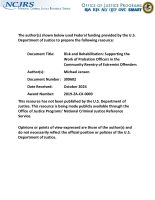Probation services
Final Report: The Electronic Monitoring of Non-Violent Convicted Felons; An Experiment in Home Detention
Risk and Rehabilitation: Supporting the Work of Probation Officers in the Community Reentry of Extremist Offenders
MEASUREMENT PRACTICE IN INTENSIVE AND SPECIAL ADULT PROBATION
Building the Capacity of Community-Facing Agencies to Implement Evidence-Based Practices
Research and Practitioner Perspectives on the Rehabilitation and Reintegration of Violent Extremists
Conceptualizing the Personal Touch Experiential Knowledge and Gendered Strategies in Community Supervision Work
The Risk-Need-Responsivity Model: How Do Probation Officers Implement the Principles of Effective Intervention?
Home Visits in Community Supervision: A Qualitative Analysis of Theme and Tone
A Multi-Level Examination of Organizational Context on Adult Probation Officer Attitudes Toward Evidence-Based Practice
Enhancing Supervision and Support for Released Prisoners
Leveraging Technology to Support Prisoner Reentry
Taking Stock: An Overview of NIJ's Reentry Research Portfolio and Assessing the Impact of the Pandemic on Reentry Research
Over several decades, the National Institute of Justice (NIJ) has made significant contributions to the field of reentry, specifically what works for whom and when. In recent years, however, the global pandemic has made it increasingly difficult to conduct research on and with populations involved with the justice system. During this time, many researchers assessing various justice-related outcomes were unable to continue their inquiries as planned due to a lack of access to their populations of interest, forcing many to pivot and rethink their research designs.
See the YouTube Terms of Service and Google Privacy Policy
Desistance From Crime: Implications for Research, Policy, and Practice
Most scholars would agree that desistance from crime – the process of ceasing engagement in criminal activities – is normative. However, there is variability in the literature regarding the definition and measurement of desistance, the signals of desistance, the age at which desistance begins, and the underlying mechanisms that lead to desistance. Even with considerable advances in the theoretical understanding of desistance from crime, there remain critical gaps between research and the application of that research to practice.
See the YouTube Terms of Service and Google Privacy Policy
Dual System Youth: At the Intersection of Child Maltreatment and Delinquency
Across the country, child welfare and juvenile justice systems now recognize that youth involved in both systems (i.e., dual system youth) are a vulnerable population who often go unrecognized because of challenges in information-sharing and cross system collaboration. In light of these challenges, national incidence rates of dual system youth are not known.
See the YouTube Terms of Service and Google Privacy Policy



